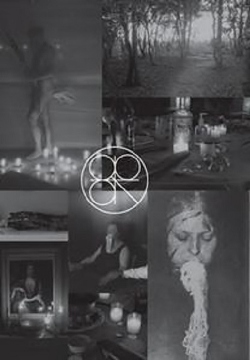A Showcase of Queer Spirits
By Maggie Hellwig in Arts & Entertainment on Mar 1, 2012 7:40PM
 When artists take on a project together, the outcome is often a phenomena worth sharing with the public. But, what happens when the documentation is deliberately censored? When the artists decide to create a record that displays only the essence of the work—not the work itself—how is the voyage to be interpreted by the recipients?
When artists take on a project together, the outcome is often a phenomena worth sharing with the public. But, what happens when the documentation is deliberately censored? When the artists decide to create a record that displays only the essence of the work—not the work itself—how is the voyage to be interpreted by the recipients?
The answer is shrouded in mystique, and yet set up strategically like merchandise in a store window. Queer Spirits, a book created by AA Bronson and Peter Hobbs, is the result of their time spent together: invoking spirits, creating art, and paying homage to queer history.
Their adventure began at the Banff Center in the Canadian Rockies. The Center, now used for artist residencies, was once a meeting place for medicine men and shamans. Hobbs and Bronson met while in residency and began a rapport. Both artists were consumed by an interest in spirituality and queer identity. In an interview with Anne Pasternak, Bronson tells the tale of his artistry and its interaction with Hobbs's work.
In 1969, Bronson created an art collective with colleagues Jorge Zontal and Felix Partz, called General Idea. The idea sprung from the playful act of constructing an imaginary storefront display, complete with an inaccessible "Back in Five Minutes" sign. The focus of the art group expanded and shifted throughout its 25 years: they attempted to challenge status quo in all kinds of ways. They created exhibits which turned the deviant subject into a part of pop culture, they sought to redefine language, and begged for a different way of perceiving modern sexuality.
During the AIDS pandemic of the 80s, they unabashedly took on the pharmaceutical industry. When both Zontal and Partz actually did pass away from AIDS, Bronson's art took a new and more somber direction toward the acts of healing and Shamanism. Bronson met Hobbs in 2008. Hobbs was an artist who had honed in on a focus of queer existence in society. Together, they created a ritual to invoke the queer spirits of Banff. Their journey continued through New Orleans, Winnipeg, Governors Island off the southern tip of Manhattan, and in the Fire Island Pines also in New York.
What they directly experienced is a complete mystery, as neither of the two gentlemen were interested in interfering with the spirits of the deceased. Hobbs states in the book that, "The shaman is not a showman." Respect for the dead is quite important in their rituals, as is the rule of non-interference during the seance; for, "If anyone is hunting, it is the ghost." Instead of a detailed description of a haunting or an intense spiritual experience, we are presented with a book full of photos and illustrations collected by Bronson, and short verbal "lessons" written by Hobbs.
One would think these trinkets wouldn't be satisfying enough, and while there is an intended element of disconnect, Hobbs and Bronson's collection are not without emotion. Larry Glawson's photos of the invocation site in Winnipeg—an abandoned store—are illuminated in a sad, and somewhat eerie, fluorescent light. On Governors Island, the remnants of the evening were left undisturbed so that the public could look upon the aftermath. Bottles of whiskey, candles, sex toys, and feathers are scattered about the floor.
In the pages following are the illustrations of Chicago's artist Elijah Burgher, showing the reader what an ideal invocation would have looked like. The display of objects, whether in the form of a public viewing or compiled in a book, resembles Bronson's early days of installation in General Idea; there is glamor in the display, but it remains at a steadfast distance. The final section of the book is written by Hobbs in small poetic installments. His tone is playful, with titles such as, "Nature is a wooly mammoth that went missing long ago," or, "The art of everyday life wears a sun god costume." He writes to us with silliness, but with sincerity - harking on the importance of history and lessons learned from his journeys.
Queer Spirits may not be for the most conservative, nor for the most austere of individuals. However, there is a grounding center upon which all of the exorbitance stands. Each location chosen for the invocations is rich in not just gay, but queer history - that is, groups which have been historically marginalized from society. Bronson and Hobbs sought out and drenched themselves in these histories not just so that they could see a ghost or two, but so that they could be part of a dialogue which has been lost. At an initial glance, we were forced to scratch our heads and ask, "Why?" But, as the case is with most artworks, the context speaks for itself.